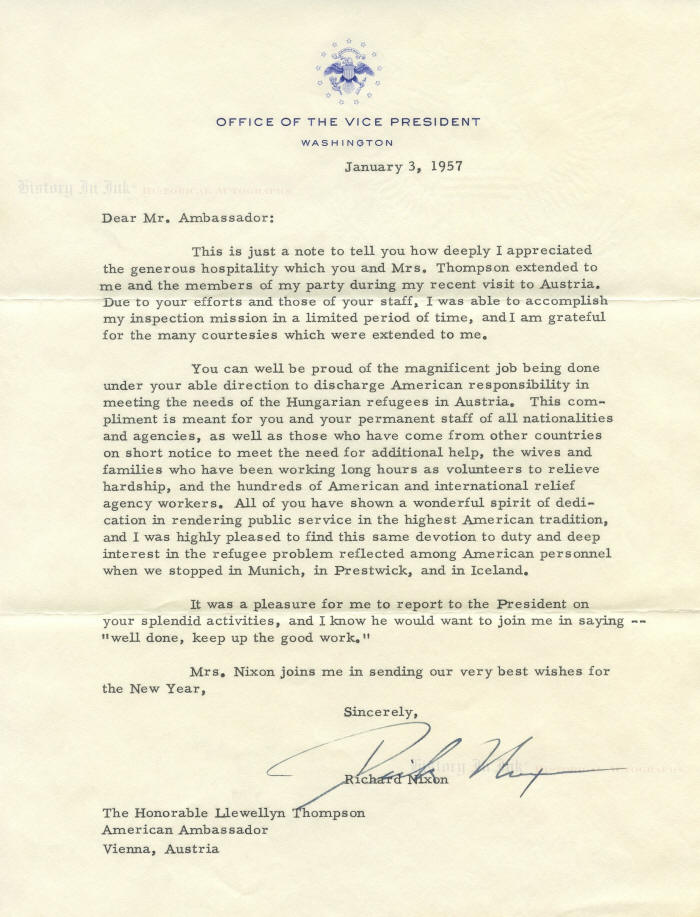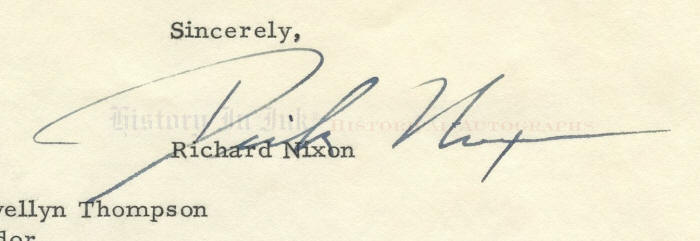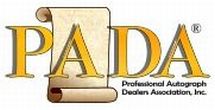

1403314
Richard M. Nixon
Scroll down to see images of the item below the description
From the Estate of Llewellyn E. Thompson,
United States Ambassador to the Soviet Union
“You can will be proud of the magnificent job being done under your able direction
to discharge American responsibility in meeting the needs of the Hungarian refugees in Austria."
Richard Milhous Nixon, 1913-1994. 37th President of the United States, 1969-1974. Typed Letter Signed, Dick Nixon, one page, 8" x 10½", on stationery of Office of the Vice President, Washington, [D.C.], January 3, 1957. With original envelope.
Nixon, then Vice President in the Eisenhower Administration, compliments Ambassador Llewellyn E. Thompson on his work to care for and resettle Hungarian refugees who had fled to Austria when the Soviet Union acted to suppress the 1956 Hungarian Revolution. Nixon writes, in full:
This is just a note to tell you how deeply I appreciated the generous hospitality which you and Mrs. Thompson extended to me and the members of my party during my recent visit to Austria. Due to your efforts and those of your staff, I was able to accomplish my inspection mission in a limited period of time, and I am grateful for the many courtesies which were extended to me.
You can will be proud of the magnificent job being done under your able direction to discharge American responsibility in meeting the needs of the Hungarian refugees in Austria. This complement is meant for you and your permanent staff of all nationalities and agencies, as well as those who have come from other countries on short notice to meet the need for additional help, the wives and families who have been working long hours as volunteers to relieve hardship, and the hundreds of American and international relief agency workers. All of you have shown a wonderful spirit of dedication in rendering public service in the highest American tradition, and I was highly pleased to find this same devotion to duty and deep interest in the refugee problem reflected among American personnel when we stopped in Munich, in Prestwick, and in Iceland.
It was a pleasure for me to report to the President on your splendid activities, and I know he would want to join me in saying – "well done, keep up the good work."
Mrs. Nixon joins me in sending our very best wishes for the New Year[.]
Nixon, a staunch anti-Communist, undoubtedly was pleased with the American effort to alleviate the problems that Hungarian refugees faced. What began as a student demonstration on October 23, 1956, became the first serious challenge to Communist authority since the Soviet Union had driven the Nazis out of Hungary and occupied Eastern Europe at the end of World War II.
Student demonstrators marched to the Parliament building in Budapest. Hungarian State Security Police detained a group of students who attempted to enter the radio building to broadcast the studentsʼ demands. The police then fired on a group of demonstrators who demanded their release and killed a student. When demonstrators wrapped the body in a flag and paraded it in central Budapest, violence erupted, and news of the event provoked unrest throughout the country. The pro-Soviet government collapsed, and a new government disbanded the State Security Police and announced its intention to withdraw from the Warsaw Pact and to hold free elections.
On October 31, the Soviet newspaper Pravda announced that the Soviet government was "prepared to enter into the appropriate negotiations with the government of the Hungarian People's Republic and other members of the Warsaw Treaty on the question of the presence of Soviet troops on the territory of Hungary." That same day, though, for various reasons, not the least of which was their unwillingness to appear weak to the United States, Soviet leaders changed their minds and decided to take military action to crush the rebellion. In the early morning hours of November 4, Soviet troops invaded Hungary. The free Hungarian government fled, and by November 7 the Soviets installed János Kádár, a former colleague of Prime Minister Imre Nagy, as the new Prime Minister. In six days, the Soviet military completely crushed the revolution. More than 2,500 Hungarians and 700 Soviet soldiers were killed. By January, the new Soviet puppet government had suppressed the opposition.
By the time the borders were sealed, 200,000 refugees had fled Hungary. Of those, approximately 180,000 fled to Austria, which borders Hungary on the west, and another 20,000 went to Yugoslavia. The massive resettlement effort, led by the office of the United Nations High Commissioner for Refugees, was unprecedented. Among 37 nations on five continents, the United States accepted 40,000 of the refugees. In the end, 180,000 refugees were resettled from Austria and Yugoslavia to the other nations.
Llewellyn E. "Tommy" Thompson (1904-1972) was a career American diplomat who served at a critical time in history as the United States Ambassador to the Soviet Union under Presidents Dwight D. Eisenhower, John F. Kennedy, and Lyndon B Johnson. Thompson joined the Foreign Service in 1928, and during his long and distinguished career he served as the United States Ambassador to Austria from 1955 to 1957 before Eisenhower appointed him Ambassador to the Soviet Union in 1957. Kennedy reappointed him to Moscow in 1961. He resigned in 1962, but Johnson reappointed him in 1967, and he served until 1969. He also held the posts of Career Ambassador and Ambassador At Large. He was part of the Executive Committee to the National Security Council, or ExComm, which advised Kennedy during the Cuban Missile Crisis in October 1962, and he was present at Johnson's summit with Soviet Premier Alexei Kosygin at Glassboro, New Jersey, in June 1967. After Nixon became President, Thompson came out of retirement to advise him on the Strategic Arms Limitation Treaty (SALT) negotiations with the Soviet Union and to serve as a member of the United States delegation to the SALT talks from 1969 until his death in 1972.
Nixon has signed this letter with a huge 4⅛" black fountain pen signature. The letter has two horizontal mailing folds, which do not affect the signature. The letter is in very fine condition, and only the folds keep it from being extra fine. The accompanying envelope, which bears Nixonʼs printed free frank, was sealed only at a tiny spot on the right side, and otherwise the glue on the flap is original. Glue stains on the bottom flaps on the back show through. The envelope was not mailed and therefore evidently was delivered by diplomatic pouch. It is in fine to very fine condition.
Provenance: This letter comes directly from the Thompson estate. It has never been offered on the autograph market before.
Unframed.
_____________
This item has been sold, but
click here to see other
Presidents and First Ladies items
that we are offering.



